|
Spatial Distribution And Habitat Preferences Of The House Sparrow, Passer domesticus In Urbanised LandscapesLorna M. Shaw, Dan Chamberlain, Greg Conway & Mike Toms
BTO Research Report 599
British Trust for Ornithology
2011
"The House Sparrow Passer domesticus has declined in urban areas across Europe since the late 1970s and is now listed as a species of conservation concern. Recent research into the causes of decline suggests that breeding populations may be influenced by a number of urban habitat features. These include pollution levels, insect abundance, nest site availability and the presence of predators. Here we examine how the presence of certain features within the urban environment relates to the location of House Sparrow colonies. We do this by comparing the distance between actual nest sites and features of interest, with that between the same features and a series of randomly-generated points. We also test the preferences of House Sparrows for a number of habitat types by using compositional habitat analysis. We found that houses with gardens were strongly preferred to any other habitat type. Interestingly, in more rural areas, allotments and greenspace were found to provide useful alternatives to houses with gardens. Predators and roads were not avoided, something that may be a result of their ubiquitous nature rather than any lack of detrimental impact. Mitigation measures to prevent the loss of House Sparrow breeding colonies should, therefore, concentrate on the maintenance and enhancement of quality urban gardens and the resources they contain. This may be of particular importance in the most densely populated urban areas."
|
Buy from amazon.co.uk 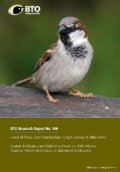
|
|
UK Hedgehog Datasets and their Potential for Long-Term MonitoringStaffan Roos, Alison Johnston & David Noble
BTO Research Report 598
British Trust for Ornithology
2011
Report for work carried out by The British Trust for Ornithology, commissioned and funded by the People's Trust for Endangered Species and the British Hedgehog Preservation Society.
|
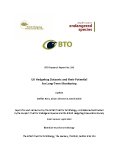 |
|
The Breeding Bird Survey 2010K. Risely, A.R. Renwick, D. Dadam, M.A. Eaton, A. Johnston, S.R. Baillie, A.J. Musgrove, & D.G. Noble
BTO Research Report 597
British Trust for Ornithology
2011
"This is the sixteenth annual report of the BTO/JNCC/RSPB Breeding Bird Survey (BBS), containing the population trends of widespread UK bird species during the period 1994–2010. The BBS is the main scheme for monitoring the population changes of the UK's common and widespread breeding birds, providing an important indicator of the health of the countryside. BBS trends are produced each year for over 100 species, and the results are widely used to set conservation priorities."
|
 |
|
No report identified
BTO Research Report 596
British Trust for Ornithology
|
 |
|
Review of European Flyways of the Lesser White-Fronted Goose Anser ErythropusJohn H. Marchant and Andy J. Musgrove
BTO Report 595
British Trust For Ornithology
2013
"The Lesser White-fronted Goose Anser erythropus (hereafter LWfG) is a small, highly migratory, Arctic - nesting goose that occupies a breeding range from Scandinavia east ward to Chukotka in eastern Siberia, and in winter occurs in scattered localities between western Europe and eastern China (del Hoyo et al 1992). Escapes and a few vagrants have been recorded in North America but breeding populations are confined to the Palearctic. Although broad from west to east, the LWfG's breeding range occupies a narrow range of latitudes, essentially at the meeting of the tundra and taiga zones, overlapping with the southern edge of the range occupied by breeding Greater White-fronted Geese A. albifrons albifrons and A. a. frontalis in Arctic Russia. The main wintering grounds of LWfG are located in northeast Greece, on the coastal plains south and west of the Caspian Sea, in the Mesopotamian region of Iraq and in the Lower Yangtze Valley in southeast China. There are many records, however, of small partie s or individual birds scattered at similar latitudes across the Palaearctic, west to the UK and Spain." |
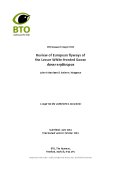 |
|
Research in support of a targeted review of the current UK network of terrestrial and coastal Special Protection Areas (SPAs)A.J. Musgrove, G.M. Siriwardena, D.G. Noble, K. Risely, & N. Calbrade
BTO Report 594
British Trust For Ornithology
2011
|
 |
|
No report identified
BTO Research Report 593
British Trust for Ornithology
|
 |
|
Strategic Ornithological Support Services Project SOSS-05: Review of bird migration routes in relation to offshore wind farm development zonesLucy J. Wright, Viola H. Ross-Smith, Graham E. Austin, Dario Massimino, Daria Dadam, Aonghais S.C.P. Cook, Neil A. Calbrade & Niall H.K. Burton
BTO Report 592
British Trust for Ornithology
2012
"The aims of this review are as follows: i. To review available information on bird migration routes in order to identify key migratory bird species for consideration in proposed Round 3, Round 1 and 2 extension and Scottish Territorial Waters offshore wind developments, and the timing of these species' migrations. ii. To collate any available information on flight heights of migrating birds, and the frequency and timing of "fall" events where migrating birds may come down to lower altitudes and could encounter wind farms, the proportion of bird species' populations that are involved in such events, and the weather conditions that cause them. iii. To provide recommendations as to how the information gathered should be used in assessing the risk to migrants of barrier effects and collision mortality in the EIA and HRA process for offshore wind farm developments and where (and for which key species) further data collection, would be required to assess these effects. iv. To identify key gaps in knowledge of important bird migration routes, flight heights, the frequency of "falls" and the effect of weather on migrating birds, and recommend what further work could be conducted to fill these gaps."
|
 |
|
The National Seawatching Workshop 11 November 2010 conclusions and recommendationsChris B. Thaxter, Nick J. Moran, A
ndy J. Musgrove, Niall H.K. Burton
BTO Report 591
British Trust for Ornithology
2011
"This report summarises the conclusions and recommendations of a workshop, funded by The Crown Estate and held at the British Trust for Ornithology in November 2010, that brought together representatives from bird observatories and other sea-watchers from around the UK and Republic of Ireland, country agencies and academics to review the potential for setting up a national sea-watching monitoring scheme. The workshop included a number of short presentations together with round-table discussions. The morning session looked into current practices, while the afternoon session focussed on the way forward."
|
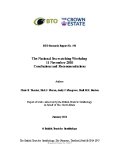 |
|
Measuring the interaction between marine features of SPAs with offshore windfarm development zones through telemetry: first breeding season reportChris B. Thaxter, Viola H. Ross-Smith, Nigel A. Clark, Greg J. Conway, Mark. M. Rehfisch, Willem Bouten and Niall H.K. Burton
BTO Report 590
British Trust for Ornithology
2011
"This study uses the latest tracking technology to investigate the movements of two seabird species that are features of SPAs. The aims of this study are threefold: i. To understand the connectivity of these feature species with the areas of consented wind farms (i.e. those which have already been constructed or are under construction) and proposed wind farm development zones; ii. To understand the extent to which these feature species use the areas of wind farms which have already been constructed or are under construction; iii. To provide an assessment of the flight altitudes o f these feature species that could usefully inform collision risk modelling. Here, we present initial findings of this two-year study covering tracking undertaken during the 2010 first breeding season."
|
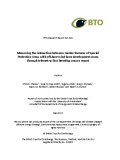 |
|
No report identified
BTO Research Report 589
British Trust for Ornithology
|
 |
|
Repeat breeding bird survey of The National Forest (English Midlands) in 2010John H Marchant, David G Noble & Steven Haynes
BTO Report 588
British Trust for Ornithology
2011
"This is the second report on breeding bird surveys in The National Forest, following the rep ort on the 2008 survey (Marchant et al. 2009). It is the first report of a series planned to provide information on population change as the Forest develops over the longer term . The sample of squares providing data for 2010 is small, however, and conclusions about population change within The National Forest since 2008 are necessarily tentative. The validity and usefulness of the results will improve progressively with future surveys."
|
 |
|
Analysis of Wetland Bird Survey (WeBS) Data for the Wash SSSI/NNRV.H. Ross-Smith, N.A. Calbrade, & G.E. Austin
BTO Report 587
British Trust for Ornithology
2011
"This study aimed to assess population trends of waterbird species in different parts of the The Wash SSSI and The Wash NNR, in order to identify areas where species were declining contrary to, or in excess of, the trend for the estuary as a whole and, furthermore, to identify sectors that were changing in terms of the proportion of species they support relative to The Wash SSSI as a whole. The effect of grazing and inflows on WeBS counts was also evaluated, as was the correspondence between breeding bird counts and WeBS core counts. The relationship between winter roost areas and feeding grounds was also investigated."
|
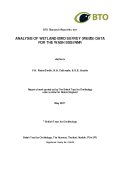 |
|
No report identified
BTO Research Report 586
British Trust for Ornithology
|
 |
|
No report identified
BTO Research Report 585
British Trust for Ornithology
|
 |
|
A survey of population changes in breeding waders on machair in Benbecula and North Uist: annual surveys in 2008-2010 and changes since the mid-1980sJ. Calladine, R. Fuller, & L. Humphreys
SNH Commission Report no. 408 / BTO Report 584
Scottish Natural Heritage / British Trust for Ornithology
2011
"This report describes surveys of breeding waders from four sites on North Uist and Benbecula (a combined total of ca. 3,550 ha) in 2008 to 2010 (Berneray, Sollas, Baleshare and Benbecula), which when combined with data from a more extensive survey in 2007, and with the survey results for the 1980s and 1990s, create a time series to allow an assessment of population changes that may be a consequence of factors other than hedgehog predation. These data will also be used to investigate relationships between vegetation composition and land use and changes in breeding wader numbers, in a partnership project with the Macaulay Land Use Research Institute."
|
 |
|
No report identified
BTO Research Report 583
British Trust for Ornithology
|
 |
|
Review and Application of Statistical Techniques to Model the At-sea
Distributions of Breeding Sandwich TernsChris B. Thaxter, Aonghais S.C.P. Cook, Alison Johnston & Niall H.K. Burton
BTO Report 582
British Trust for Ornithology
2011
"A large number of seabird colonies have been designated as Special Protection Areas (SPAs) in the UK due to the international or national importance of their breeding seabird populations. However, to date, the associated ma rine foraging grounds of these seabirds have not been designated. While this requirement has long been recognised, standard methodologies for assessing the precise boundaries of foraging grounds for designation are still being developed. The aim of this work was to identify and implement the most suitable approach for modelling the at-sea foraging distribution of Sandwich Terns Sterna sandvicensis breeding in the North Norfolk Coast SPA, using data collected on the species' foraging locations from that SPA and associated environmental datasets. This will aid Natural England in the identification of a possible extension to the North Norfolk Coast SPA, and also inform on the Joint Nature Conservation Committee's anticipated UK-wide approach for identifying marine extensions, or additional areas, to breeding seabird colony SPAs."
|
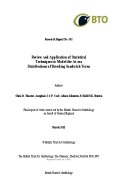 |
|
An evaluation of bird populations on pea growers farms between 2007 and 2010 and relative to neighbouring farmlandI. Henderson
BTO Report 581
British Trust for Ornithology
2011
"In the UK, pea crops, despite covering a relatively small total crop area, have a high potential to contribute to significant densities of several bird species of high conservation concern on farmland, both within the crop itself and by increasing the complexity of a rotation or landscape. Pea crops may potentially contribute directly or indirectly to bi rd conservation on farmland, given sympathetic crop management, improved awareness among farm operators and advisors, and improved knowledge of the crops' value relative to surrounding crops, habitats, refuges and foraging sites. But farmers who accept Birds Eye sustainable agriculture guidelines on sustainable management are likely to farm the complete rotation in the same diligent manner. It is hoped that their efforts are reflected in the numbers of birds occurring on the farmland and boundaries. For this reason the study in 2010 was completed as part of the standard monitoring of the sustainable agriculture programme and potential effects on biodiversity. In 2010 farm visits were arranged in order to identify whether there were detectable differences between bird populations on growers farms relative to the surrounding farmed countryside and to assess their overall performance against a national benchmark."
|
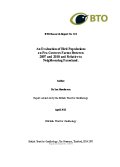 |
|
Identifying a range of options to prevent or reduce avian collision with offshore wind farms, using a UK-based case studyA. S. C. P. Cook, V. H. Ross-Smith, S. Roos, N.H.K. Burton, N. Beale, C. Coleman, H. Daniel, S. Fitzpatrick, E. Rankin, K. Norman, & G. Martin
BTO Report 580
British Trust for Ornithology
2011
"This project aims to review and evaluate potential mitigation options for preventing or reducing avian collisions with offshore wind farms. Offshore wind farms may potentially affect bird populations through the displacement of birds due to the disturbance associated with developments, the barrier they present for migrating birds and birds commuting between breeding sites and feeding areas, habitat change or loss and through collision mortality."
|
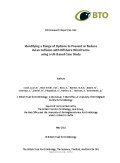 |
|
The influence of vegetable production on farmland bird populationsGavin M. Siriwardena and Mark F. Hulme
BTO Report 579
British Trust for Ornithology
2011
"There is reason to believe that horticultural cropping provides high quality habitat for a range of farmland bird species, but objective evidence for this has not yet been published. Here, the scientific literature relevant to this issue is reviewed and national bird population data from the BTO/JNCC/RSPB Breeding Bird Survey (BBS) are analysed to look for differences in bird numbers ("abundance"), population trends over time and species diversity between farmland with and without horticultural crops, as indicated by the presence of HDC-registered growers in the local area."
|
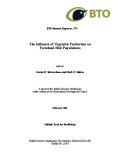 |
|
Analyses to assess the effectiveness of modifications to the BBS sampling designS.N. Freeman and D.G. Noble
BTO Report 578
British Trust for Ornithology
2011
|
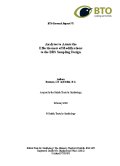 |
|
The BTO Barn Owl Monitoring Programme: Final Report 2000-2009D. Dadam, C.J. Barimore, C.R. Shawyer & D.I. Leech
BTO Report 577
British Trust for Ornithology
2011
"The Barn Owl Monitoring Programme (BOMP), funded by the Sheepdrove Trust, was initiated in 2000. The main aim of the project was to provide a mechanism for monitoring annual changes in size of the Birds of Conservation Concern (BoCC) Amber-listed Barn Owl population in the UK. As existing transect-based diurnal surveys such as the BTO/JNCC/RSPB Breeding Bird Survey (BBS) provided poor coverage of the species, BOMP methodology involved the regular visitation of an established network of nest sites to assess occupancy. This approach also permitted the collection of data on breeding success and, through the ringing that occurred at the majority of sites, on survival and dispersal of young and adult birds."
|
 |
|
No report identified
BTO Research Report 576
British Trust for Ornithology
|
 |
|
No report identified
BTO Research Report 575
British Trust for Ornithology
|
 |
|
Waterbirds on English Sites of Special Scientific Interest: A review of the use made by non-breeding waterbirds of the English SSSI networkN.A. Calbrade, A.J. Musgrove, & G.E. Austin
BTO Research Report 574
British Trust for Ornithology
2011
"Natural England is undertaking a comprehensive review of the coverage of species and habitats by SSSIs. As part of this work, information is required on the coverage of breeding and non-breeding bird populations. The latter is addressed by this report."
|
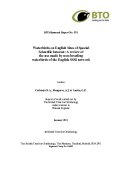 |
|
How representative is the current monitoring of breeding seabirds in the UK?A.S.C.P. Cook & R.A. Robinson
BTO Research Report 573
British Trust for Ornithology
2010
"The main aim of this study is to determine if the current monitoring of seabirds as carried out as par t of the SMP is sufficient to produce trends in abundance and breeding success at a regional and UK scale and that are sufficiently precise to detect policy-relevant change over time. Species to be included are those for which the quality of monitoring data is high, including Northern Fulmar, Northern Gannet, European Shag, Great Cormorant, Arctic Skua, Sandwich Tern, Little Tern, Herring Gull, Black-legged Kittiwake, Common Guillemot and Razorbill."
|
 |
|
An examination of reptile and amphibian populations in gardens, the factors influencing garden use and the role of a 'Citizen Science' approach for monitoring their populations within this habitatElizabeth Humphreys, Mike Toms, Stuart Newson, John Baker and Kathy Wormald
BTO Research Report 572
British Trust for Ornithology
2011
"This report considers the factors that might influence garden use by reptile and amphibian species, before going on to make recommendations for management options within individual gardens. Data from the 'Reptiles and Amphibians in your Garden Survey' (RAGS) are used to examine those factors influencing garden use, including those present within individual gardens as well as in the wider landscape which surrounds them . This report also examines the potential value of data collected through the BTO Garden BirdWatch for monitoring long-term trends in garden use by reptile and amphibian species."
|
 |
|
Assessment of ornithological survey protocols and focal species in relation to the proposed Dogger Bank Wind Farm development
BTO Research Report 571
British Trust for Ornithology
2011
|
 |
|
No report identified
BTO Research Report 570
British Trust for Ornithology
|
 |
|
No report identified
BTO Research Report 569
British Trust for Ornithology
|
 |
|
Understanding the role of avian vectors in the spread of Phytophthora ramorumE. Coleman & J.A. Clark
BTO Research Report 568
British Trust for Ornithology
2010
|
 |
|
No report identified
BTO Research Report 567
British Trust for Ornithology
|
 |
|
Multi-scale relationships between vegetation pattern and breeding birds in the upland margins (ffridd) of North WalesGreg
J. Conway & Robert J. Fuller
BTO Research Report 566
British Trust for Ornithology
2010
"The marginal uplands of Wales are typified by complex mosaics of vegetation, broadly referred to as ffridd, that are increasingly recognised as valuable for biodiversity, especially birds and invertebrates. This report presents a detailed examination of how bird distributions at site, habitat patch, territory and individual bird scale s relate to vegetation structure and composition within the ffridd. This assessment of bird - habitat preferences is based on work undertaken in 2008 and 2009 in Snowdonia and the Berwyn, north Wales. The results should also be relevant to the management of similar upland fringe environments in western and northern Britain. The data gathered create a baseline against which future changes in vegetation and birds within ffridd habitats can be assessed."
|
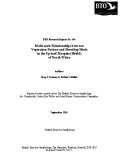 |
|
Breeding birds in the wider countryside: their conservation status 2010Stephen Baillie, John Marchant, David Leech, Anna Renwick, Andrew Joys, David Noble, Carl Barimore, Greg Conway, Iain Downie, Kate Risely and Rob Robinson
BTO Research Report 565
British Trust for Ornithology
2010
|
 |
|
The Building Bird Monitoring in Scotland ProjectMandy Cook, David Jardine, Chris Waltho & Chris Wernham
BTO Research Report 564
British Trust for Ornithology / The Scottish ornithologists Club
2010
"The Building Bird Monitoring in Scotland (BBMS) Project 2007-2010 aimed to motivate more birdwatchers and other countryside users to get involved in bird recording through a range of activities to support and inspire them, and by providing support to BTO and Scottish Ornithologists' Club (SOC) local voluntary representatives to empower them to engage more volunteers themselves. BBMS activities included: three central national weekend meetings to share best practice amongst regional volunteer coordinators; 19 one-day training events for existing and potential volunteers; an annual bespoke newsletter for volunteer bird recorders; three new promotional leaflets; and the advertising of opportunities for volunteers through a range of media and in collaboration with a range of partner organizations (particularly those associated with hillwalking and countryside management communities of potential volunteers)."
|
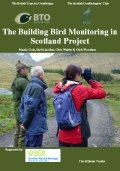 |
|
A review of the potential impact and marine aggregate extraction on seabirds and waterbirdsA.S.C.P Cook & N.H.K. Burton
BTO Research Report 563
British Trust for Ornithology / Marine Aggregate Levy Sustainability Fund
2010
|
 |
|
No report identified
BTO Research Report 562
British Trust for Ornithology
|
 |
|
Trends among breeding water birds during 1974-2009, along canals in British Waterways ownershipJohn H. Marchant, Mark F. Hulme &
David G. Noble
BTO Research Report 561
British Trust for Ornithology
2010
|
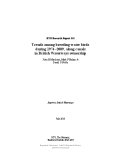 |
|
Waterways Breeding Bird Survey: progress 1998-2009 and long-term population trendsJohn H. Marchant, Mark F. Hulme &
David G. Noble
BTO Research Report 560
British Trust for Ornithology
2010
|
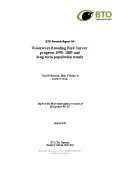 |
|
The Breeding Bird Survey 2009K. Risely, S.R. Baillie, M.A. Eaton, A.C. Joys, A.J. Musgrove, D.G. Noble, A.R. Renwick, & L.J. Wright
BTO Research Report 559
British Trust for Ornithology
2010
"The BBS is the main scheme for monitoring the population changes of the UK's common and widespread breeding birds, providing an important indicator of the health of the countryside. BBS trends are produced each year for over 100 species, and the results are widely used by government and non-governmental organisations to set conservation priorities. The BBS was launched in 1994, to provide more representative habitat coverage than the main survey running at the time, the Common Birds Census (CBC). The CBC ended in 2000, and the overlap period between 1994 and 2000 allowed the BTO to develop methods for calculating long-term trends (from the 1960s to the present) using information from both schemes. The most recent joint CBC/BBS trends are published in the Wider Countryside Report, available at www.bto.org/birdtrends."
|
 |
|
No report identified
BTO Research Report 558
British Trust for Ornithology
|
 |
|
The BTO Barn Owl Monitoring Programme 2000-2008D.I. Leech, C.J. Barimore, C.R. Shawyer & S.E. Newson
BTO Report 557
British Trust for Ornithology
2010
"The Barn Owl Monitoring Programme (BOMP) was set up in 2000 as a means of monitoring Barn Owl populations in the UK. This species is poorly monitored by other BTO surveys, such as the Breeding Bird Survey, because it is largely nocturnal, is not vocal and occurs at low densities. To overcome these problems, BOMP methodology asks participants to visit known nest sites on an annual basis to determine whether Barn Owls are breeding and to collect information on breeding success. These data are collated at the BTO each year and analysed, with the aim of producing annual trends in occupancy rates and breeding parameters. The value of BOMP is shown by the inclusion of its results in the annual publication The State of the UK's Birds (e.g. Eaton et al. 2009a). This report presents an analysis of the first nine years of BOMP data (2000-2008)."
|
 |
|
Wetland Bird Survey Alerts 2006/2007: changes in numbers of wintering waterbirds in the constituent countries of the United Kingdom, Special Protection Areas (SPAs) and Sites of Special Scientific Interest (SSSIs)C.B. Thaxter, A. Sansom, R.M. Thewlis, N.A. Calbrade & G.E. Austin
BTO Report 556
British Trust for Ornithology
2010
|
 |
|
An update of the population trends of selected UK mammals 1995–2008 using BBS & WBBS mammal dataL.J. Wright, C.B. Thaxter, K. Risely, J.H. Marchant & D.G. Noble
BTO Report 555
British Trust for Ornithology
2010
|
 |
|
No report identified
BTO Research Report 554
British Trust for Ornithology
|
 |
|
The effects on waterbirds of dredging at the Cardiff Bay Barrage. Report for 2009/10A.S.C.P. Cook & N.H.K. Burton
BTO Research Report 553
British Trust for Ornithology
2010
|
 |
|
Bird survey assessment for Bayer CropScience, Great ChishillMark F. Hulme and Gavin M. Siriwardena
BTO Research Report 552
British Trust for Ornithology
2010
|
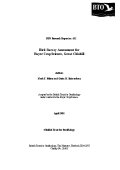 |
|
Reducing the risk of exposure of free range poultry to highly pathogenic Avian Influenza (H5N1) in BritainSimon Pickett, Rachel Coombes, Alex Sansom, Andy Musgrove and Gavin Siriwardena
BTO Research Report 551
British Trust for Ornithology
2010
|
 |
|
Second year of ornithological surveys at House of Water, East Ayrshire: breeding season 2009 and winter season 2009-10John Calladine & Andre Thiel
BTO Research Report 550
British Trust for Ornithology
2010
"Coal extraction at House of Water, west of New Cumnock in East Ayrshire, necessitated the diversion in 2000 and subsequent re-diversion to its former route of the River Nith, a river of major importance as a salmon and sea trout fishery, and of one of its tributaries, the Beoch Lane. Completed in 2004, at 3 km in length this is believed to be the largest river diversion project in Europe. This report describes and gives the results of surveys of breeding birds in 2009 and of birds present in winter 2009-10, the second successive seasons of ornithological surveys of the restored section of the river. The principal focus is on birds that utilise the re-diverted section of the river bu t we have also taken the opportunity to survey birds in the adjacent area, including restored ground and newly created wetlands, comprising an area of about 180 ha. This is larger than the 72 ha surveyed in the original 2008-09 seasons (Calladine & Thiel 2009) when only immediately adjacent areas to the river were surveyed. The original 72 ha survey area was included in 2009-10 in its entirety, however, and direct comparisons between the two years are made."
|
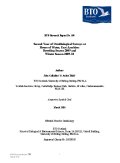 |
|
Final report for 2009 on the Scottish Woodland Breeding Bird SurveysSarah Eglington & David Noble
BTO Research Report 549
Forestry Commission Scotland / British Trust for Ornithology
2010
|
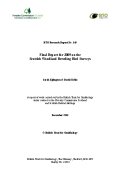 |
|
Within-site waterbird trends relative to whole-site and regional population trends: the South Lincs. Shooting zone on The Wash SPAGraham Austin and Neil Calbrade
BTO Research Report 548
British Trust for Ornithology
2010
|
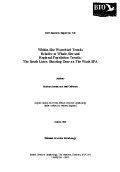 |
|
No report identified
BTO Research Report 547
British Trust for Ornithology
|
 |
|
Within-site waterbird trends relative to whole-site, regional and national population trends: Dungeness, Romney Marsh and Rye Bay SSSIGraham Austin and Neil Calbrade
BTO Research Report 546
British Trust for Ornithology
2010
|
 |
|
No report identified
BTO Research Report 545
British Trust for Ornithology
|
 |
|
No report identified
BTO Research Report 544
British Trust for Ornithology
|
 |
|
Woodlark and Nightjar recreational disturbances and nest predator studyG. Conway, I. Henderson, S. Schäfer, S. Pickett, M. Hulme, K. Skelhorn, C. Holt & A. Prior
BTO Research Report 543
British Trust for Ornithology
2010
|
 |
|
A survey of Nightjar flight heights at Clocaenog Forest in 2009Neil Calbrade and Ian Henderson
BTO Research Report 542
British Trust for Ornithology
2009
|
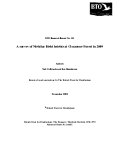 |
|
Breeding birds in the wider countryside: their conservation status 2009Stephen Baillie, John Marchant, David Leech, Andrew Joys, David Noble, Carl Barimore, Greg Conway, Iain Downie, Kate Risely and Rob Robinson
BTO Research Report 541
British Trust for Ornithology
2010
|
 |
|
Methods for comparing low-tide trends for Wetland Bird Survey count sectors with wider regions: a pilot study for three wader species on the Stour and Orwell Estuaries SPAJohn H. Marchant, Neil A. Calbrade & Graham E. Austin
BTO Research Report 540
British Trust for Ornithology
2009
|
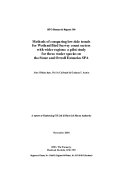 |
|
A baseline breeding bird survey of Perth & Kinross in 2008John H Marchant & David G Noble
BTO Research Report 539
British Trust for Ornithology
2009
|
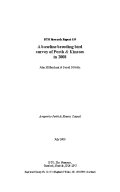 |
|
No report identified
BTO Research Report 538
British Trust for Ornithology
|
 |
|
The Breeding Bird Survey 2008K. Risely, D.G. Noble, S.R. Baillie
BTO Research Report 537
British Trust for Ornithology
2009
"This is the fourteenth annual report of the BTO/JNCC/RSPB Breeding Bird Survey (BBS), containing the population trends of widespread UK bird species during the period 1994–2008. As well as the national trends, specific population trends are presented for birds in England, Scotland, Wales, Northern Ireland, and for the nine English Government Office Regions. We also give details of current research using BBS data, and report on mammal monitoring."
|
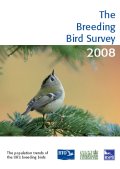 |
|
No report identified
BTO Research Report 536
British Trust for Ornithology
|
 |
|
Raptor species conservation frameworks: The Peregrine Conservation Framework Project. Progress report - phase 1Liz Humphreys, Chris Wernham and Humphrey Crick
BTO Research Report 535
British Trust for Ornithology
2009
|
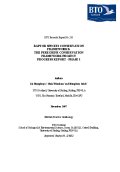 |
|
Ornithological surveys at House of Water, East Ayrshire: breeding season 2008 and winter season 2008-09John Calladine & Andre Thiel
BTO Research Report 534
British Trust for Ornithology
2009
"Coal extraction at House of Water, near New Cumnock in East Ayrshire, necessitated the diversion in 2000 and subsequent re-diversion to its former route of the River Nith, a river of major importance as a salmon and sea trout fishery, and one of its tributaries, the Beoch Lane. Completed in 2004, at 3 km in length it is believed to be the largest river diversion project in Europe . This report describes and gives the results of surveys of breeding birds in 2008 and of birds present in winter 2008-09, the first ornithological surveys of the restored section of the river. The principal focus is on birds that utilise the re-diverted section of the river but we have also taken the opportunity to monitor birds on the immediately adjacent area, including restored ground and newly created wetlands, comprising an area of about 72 ha."
|
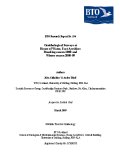 |
|
A review of UK agricultural biofuels: potential effects on birds and knowledge gaps for bird conservation in the UKI. Henderson
BTO Research Report 533
British Trust for Ornithology
2009
|
 |
|
Assessment of sugar beet field trials and the potential to support farmland birdsI.G. Henderson & C.A. Holt
BTO Research Report 532
British Trust for Ornithology
2009
|
 |
|
No report identified
BTO Research Report 531
British Trust for Ornithology
|
 |
|
The effects on waterbirds of dredging at the Cardiff Bay Barrage: report for 2008/09A.S.C.P. Cook & N.H.K. Burton
BTO Research Report 530
British Trust for Ornithology
2009
|
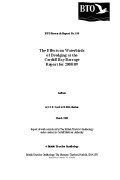 |
|
Analysis of Islay goose datasets to determine the effects of scaring and management factors on goose distributions: Phase IIDavid Douglas, Graham Austin, Chris Wernham and Mark Rehfisch
BTO Research Report 529
British Trust for Ornithology
2009
"BTO Scotland has been contracted by the Scottish Executive Environmental and Rural Affairs Department (now Scottish Government: Rural and Environment Research and Analysis Directorate) to conduct an analysis of datasets, collected between the winter seasons of 1992/93 a nd 2006/07, on wintering Greenland White- fronted Goose (Anser albifrons flavirostris) and Greenland Barnacle Goose (Branta leucopsis) populations on Islay, Argyll. A programme of scaring (shooting and non-shooting scaring devices) has been in operation on the island since 2000/01 as part of the Islay Goose Management Scheme, with the aim of reducing the extent of agricultural damage by geese on Islay. The main aspect of this current project is to investigate whether the datasets collected within this scheme can be used to determine the effectiveness of the various scaring techniques."
|
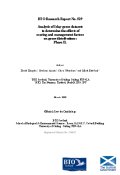 |
|
Collation of existing survey data on heathland birds breeding on English SSSIsN.H.K. Burton, G.E. Austin & G.J. Conway
BTO Research Report 528
British Trust for Ornithology
2009
|
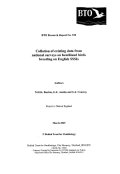 |
|
The potential implications for birds of reform of the sugar beet industry in EnglandSimon Gillings, Phil W. Atkinson, Mike J. May, Robert J. Fuller
BTO Research Report 527
British Trust for Ornithology
2009
|
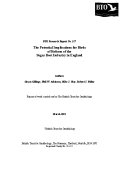 |
|
The feasibility of integrated population monitoring of Britain's sea birdsRobert A. Robinson & Norman Ratcliffe
BTO Research Report 526
British Trust for Ornithology
2009
|
 |
|
Will Woodlands: a reconnaissance survey of habitat composition, configuration and the wild bird potential of three developing woodland sitesIan Henderson
BTO Research Report 525
British Trust for Ornithology
2009
|
 |
|
No report identified
BTO Research Report 524
British Trust for Ornithology
|
 |
|
The BTO Barn Owl Monitoring Programme 2000-2007D.I. Leech, C.J. Barimore & C.R. Shawyer
BTO Report 523
British Trust for Ornithology
2008
"The Barn Owl Monitoring Programme (BOMP) was set up in 2000 as a means of monitoring Barn Owl populations in the UK. This species is poorly monitored by other BTO surveys, such as the Breeding Bird Survey, as it is an elusive bird being mostly active at night, is largely non-vocal and occurs at low densities. To overcome these problems, BOMP methodology involves participants visiting known nest sites annually to ascertain whether Barn Owls are using them each year and to collect data about the productivity of any breeding attempts observed. Each year the data are collated at the BTO and analysed, with the aim of producing annual trends in occupancy rates and a range of breeding parameters. The value of BOMP is shown by the inclusion of its results in the annual publication The State of the UK's Birds (e.g. Eaton et al. 2004) and in the reports of the Rare Breeding Birds Panel (e.g. Ogilvie & RBBP 2003). This report presents an analysis of the first eight years of BOMP data (2000-2007)."
|
 |
|
Towards developing sustainable, biodiversity-rich agricultural systems in UgandaD.E. Chamberlain, R. Katebaka, I. Senfuma, D. Pomeroy, D. Nalwanga-Wabire, A. Byaruhanga, P.W. Atkinson & J.A. Vickery
BTO Research Report 522
British Trust for Ornithology
2009
|
 |
|
No report identified
BTO Research Report 521
British Trust for Ornithology
|
 |
|
A breeding bird survey of the National Forest (English Midlands) in 2008John H Marchant, David G Noble & Steven Haynes
BTO Research Report 520
British Trust for Ornithology
2009
|
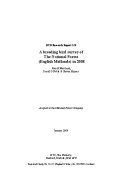 |
|
No report identified
BTO Research Report 519
British Trust for Ornithology
|
 |
|
No report identified
BTO Research Report 518
British Trust for Ornithology
|
 |
|
No report identified
BTO Research Report 517
British Trust for Ornithology
|
 |
|
Breeding birds in the wider countryside: their conservation status 2008Stephen Baillie, John Marchant, David Leech, Andrew Joys, David Noble, Carl Barimore, Greg Conway, Iain Downie, Kate Risely and Rob Robinson
BTO Research Report 516
British Trust for Ornithology
2009
|
 |
|
No report identified
BTO Research Report 515
British Trust for Ornithology
|
 |
|
Breeding Plover Survey for common standards 2007: assessments of changes in a number of breeding waders on SPAs designated Ringed Plovers Charadrius hiaticulaG. Conway, N. Burton & R. Fuller
BTO Research Report 514
British Trust for Ornithology
2008
|
 |
|
Developing techniques for ornithological cumulative impact assessmentI.M.D. Maclean, M.M. Rehfisch & S. King
BTO Research Report 513
British Trust for Ornithology
2008
|
 |
|
Waterbird populations on the Wider Thames Estuary: Numbers and trends by count sectorL.J. Wright, G.E. Austin, I.M.D. Maclean, & N.H.K. Burton
BTO Research Report 512
British Trust for Ornithology
2008
|
 |
|
The effects on waterbirds of a new outfall discharging water into Mansbrook Grove on the Orwell Estuary: 2005/06 to 2007/08 final reportN.H.K. Burton & N.O.M. Ravenscroft
BTO Research Report 511
British Trust for Ornithology
2008
|
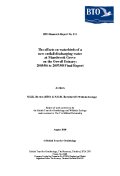 |
|
UK Population Estimates from the 2007 Breeding Little Ringed Plover and Ringed Plover SurveysG. J. Conway, N.H.K. Burton, M. Handschuh, G.E. Austin
BTO Report 510
British Trust For Ornithology
2008
"This report summarises the results of the 2007 Breeding Little Ringed Plover Charadrius dubius and Ringed Plover C. Hiaticula surveys and provides new population estimates for the two species in the United Kingdom and its constituent countries. The surveys were the first country-wide surveys of these two species since 1984."
|
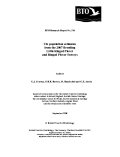 |
|
No report identified
BTO Research Report 509
British Trust for Ornithology
|
 |
|
The Breeding Bird Survey 2007K. Risely, D.G. Noble, S.R. Baillie
BTO Research Report 508
British Trust for Ornithology
2008
"This is the thirteenth annual report of the BTO/JNCC/RSPB Breeding Bird Survey (BBS), covering the years 1994 to 2007. The aim of the survey is to monitor population trends for a range of common and widespread bird species in the UK. BBS results are increasingly used by UK Government and non-governmental organisations to set conservation priorities. The scheme is run centrally by BTO staff, and coordinated by a network of volunteer BTO Regional Organisers, who play a crucial role in organising and encouraging volunteer effort. Information about BBS, and the latest results, can be found at www.bto.org/bbs, and more detailed information about population trends can be found at
www.bto.org/birdtrends."
|
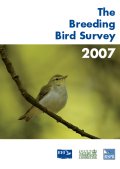 |
|
No report identified
BTO Research Report 507
British Trust for Ornithology
|
 |
|
Development of wild bird indicators for freshwater wetlands and waterways: documentation of recommended and alternative approachesD. Noble, A. Joys, L.J. Wright & M. Everard
BTO Research Report 506
British Trust for Ornithology
2008
|
 |
|
Colne Estuary low tide counts 2007/08N.A. Calbrade, A.J. Musgrove & M.R. Rehfisch
BTO Research Report 505
British Trust for Ornithology
2008
|
 |
|
A marine assessment and monitoring framework for application by UKMMAS and OSPAR: Review of coastal waterbird indicators and identification of gapsI.M.D. Maclean, L.J. Wright, G.E. Austin, M.M. Rehfisch
BTO Research Report 504
British Trust for Ornithology
2008
|
 |
|
Assessing population change of breeding Ringed Plovers in the UK between 1984 and 2007G.J. Conway, N.H.K. Burton
BTO Report 503
British Trust For Ornithology
2008
"The 2007 Breeding Little Ringed Plover (Charadrius dubius) and Ringed Plover (C. hiaticula) Survey was the first UK-wide survey of these two species since 1984. That survey revealed a total of c. 8,540 pairs of Ringed Plover in Britain (Prater 1989). England held about 2,390 pairs, Wales an estimated 220 pairs, Northern Ireland 130 pairs and Scotland c. 5,800 pairs, i.e. two thirds of the total population. The 1984 survey also revealed a population of 608-631 pairs of Little Ringed Plover (confined to England and Wales: Parrinder 1989). The latest population estimate of 825-1,070 summering pairs comes from the 1988-91 New Atlas of Breeding Birds in Britain and Ireland (Gibbons et al. 1993). The 2007 survey not only provides the opportunity to update population estimates for the two species, but also to assess how the species' populations have changed and the likely influences. Breeding Little Ringed Plovers and Ringed Plovers are particularly prone to disturbance, as with other plover species (Liley 1999, Lafferty et al. 2006, Tratalos et al. 2005, Liley & Sutherland 2007, Montalvo & Figuerola 2006, Yasué & Dearden 2006, Long et al. 2008), and it is thus likely that the species will have fared relatively less well where human population densities are greatest. In this report we examine large- scale spatial variation in population change of Ringed Plover between 1984 and 2007 and investigate whether population change in England and Wales was related to human population density. Change is evaluated by comparing the numbers of pairs recorded on sites surveyed in both 1984 and 2007. This approach is less suitable for assessing population change of Little Ringed Plovers, as their breeding habitats are far more ephemeral. Thus sites occupied in 1984 may have become unsuitable for breeding, for example due to vegetation growth, but birds simply redistributed to other newly created local sites."
|
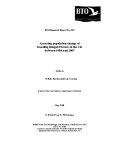 |
|
Association of British breeding birds with freshwater wetland habitatsMark Everard & David Noble
BTO Research Report 502
Environment Agency / British Trust for Ornithology
2008
|
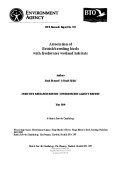 |
|
2007 Non-estuarine Coastal Waterbird Survey: population estimates and broad comparisons with previous surveysG.E. Austin, M.P.Collier & M.M. Rehfisch
BTO Research Report 501
British Trust for Ornithology
2008
"This document reports estimates for numbers of waders on the open coast of the UK during the winter of 2006/07. In due course, these new estimates, and where appropriate similar estimates for wildfowl, will feed directly revised population estimates for wintering waterbirds. Furthermore, we consider in broad terms how numbers compare to those estimated from the previous two surveys as a prelude to more sophisticated analyses to be undertaken in due course."
|
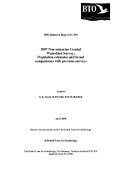 |
|
Marine Monitoring Project: ground and aerial monitoring of inshore Special Protection Areas: Common Scoters in Carmarthen Bay 2007-2008I.M.D.Maclean, P.A. Cranswick, N.P. Fairney, L.E. Smith, C. Hall, A.J. Musgrove, B. Haycock, W.W. Sanderson, S. Whitehead & M.M. Rehfisch
BTO Research Report 500
British Trust for Ornithology
2008
|
 |